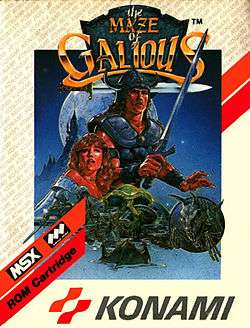The Maze of Galious
| The Maze of Galious | |
|---|---|
 Cover art | |
| Developer(s) | Konami |
| Publisher(s) | Konami |
| Designer(s) | Ryouhei Shogaki |
| Composer(s) |
Kazuhiko Uehara (MSX) Hidenori Maezawa, Shinya Sakamoto, Atsushi Fujio, Kiyohiro Sada, Kinuyo Yamashita (NES) |
| Platform(s) | MSX, Family Computer, i-Revo, Windows Store (Project EGG) |
| Release date(s) |
MSX
Family Computer
i-Revo
PC (Project EGG)
|
| Genre(s) | Platform game, Metroidvania[1] |
| Mode(s) | Single-player |
The Maze of Galious (魔城伝説II ガリウスの迷宮 Majō Densetsu Tsū: Gariusu no Meikyū), is the sequel to Konami's MSX game Knightmare. While the first game was an overhead, vertical scrolling shooter, The Maze of Galious is a side-view, flick-screen platform game. The player controls Popolon and Aphrodite, entering the evil priest Galious' castle to free their yet-to-be-born son Pampas from the priest's evil clutches. Being able to control Popolon and Aphrodite means the player can switch between two characters that have slightly different abilities. For example, Popolon can push stones and open heavy doors. On the other hand, Aphrodite survives longer under water and she can shoot more projectiles. Should either character die, the other can visit a shrine and pay for resurrection. Unlike typical platform games, both characters can survive some damage as they have hit point bars.
The game has several types of enemies, each with strengths and weaknesses. Some monsters are immune to frontal attacks, some are more vulnerable to fire and so on. Ten different bosses are to be fought too. Defeating a boss will give the player a key that is used to unlock doors to other boss areas. In-game saving is provided by giving player an encoded password.
Conversions
- A Family Computer version of Majou Densetsu II was released exclusively in Japan a few months after the MSX release. The Famicom version, titled Majō Densetsu II: Daima Shikyou Galious (魔城伝説II 大魔司教ガリウス), is a completely redesigned version of the game.
Trivia
- The Maze of Galious offers extra bits and bonuses if The Game Master, Knightmare or Q*bert are inserted in the second cartridge slot available on some MSX machines.
- La-Mulana is a homage to MSX games in general and The Maze of Galious especially, and borrows many elements from the game. It also contains a bonus area designed to look like a The Maze of Galious level, in which the MSX cartridge of the original game can be found as an in-game item.
- The indie game Unepic also features a homage to The Maze of Galious, where the player enters a "retro" room which features a tombstone that reads "Hamalech", the name of the final boss in The Maze of Galious, and has a very similar color pattern and design.
References
- ↑ Jiminez, Javier (February 15, 2014). "Unepic (Wii U eShop) Second Opinion Review". Cubed3. Retrieved July 11, 2016.
Unepic cleaves closer to Galious than any other game, not just with homages (though it has several) but in terms of gameplay and level design as well. Right from the off, it looks like a prototypical NES Metroidvania.